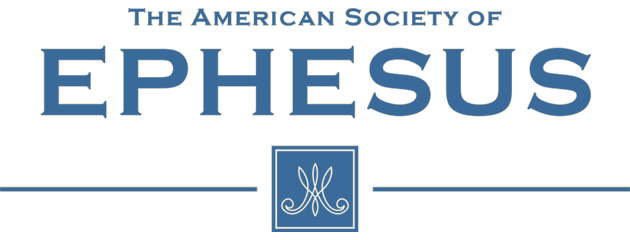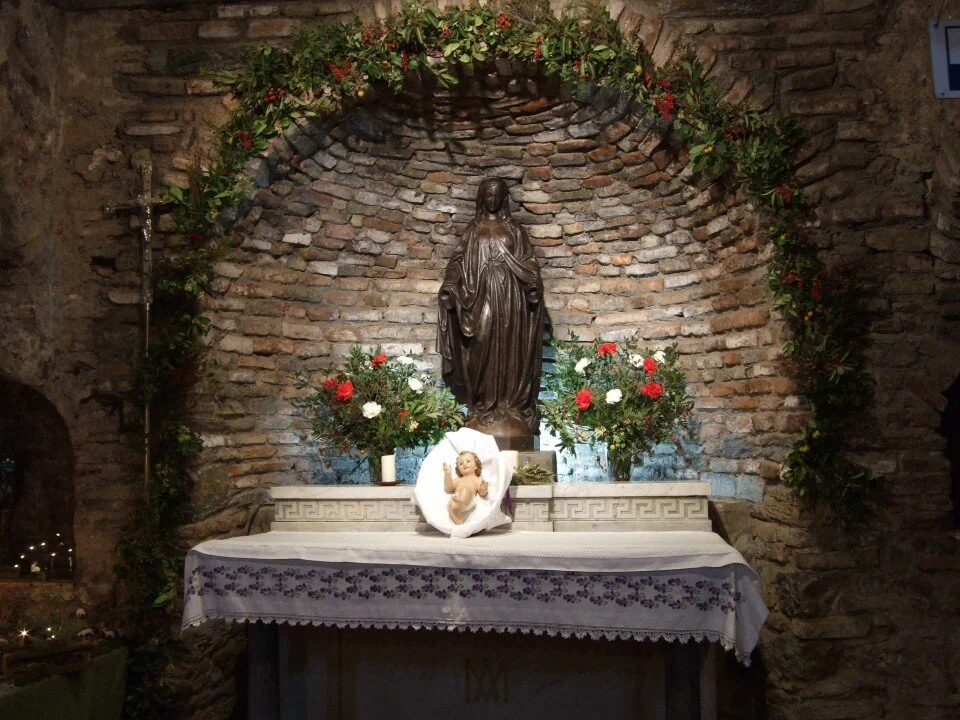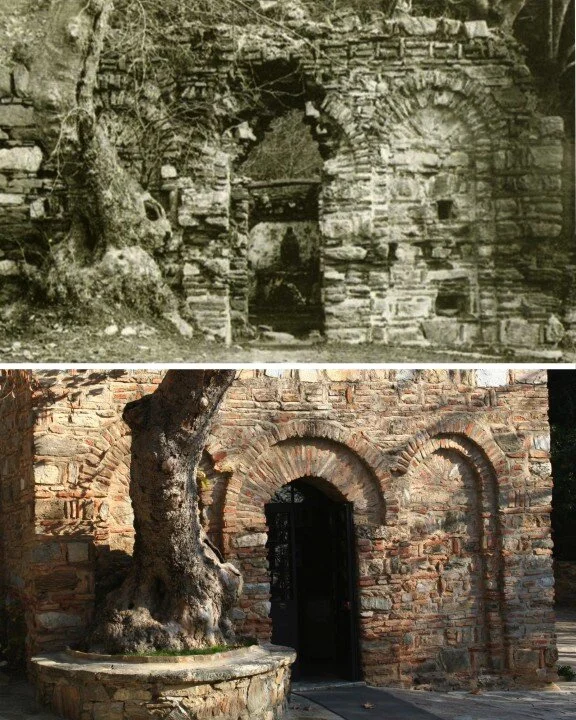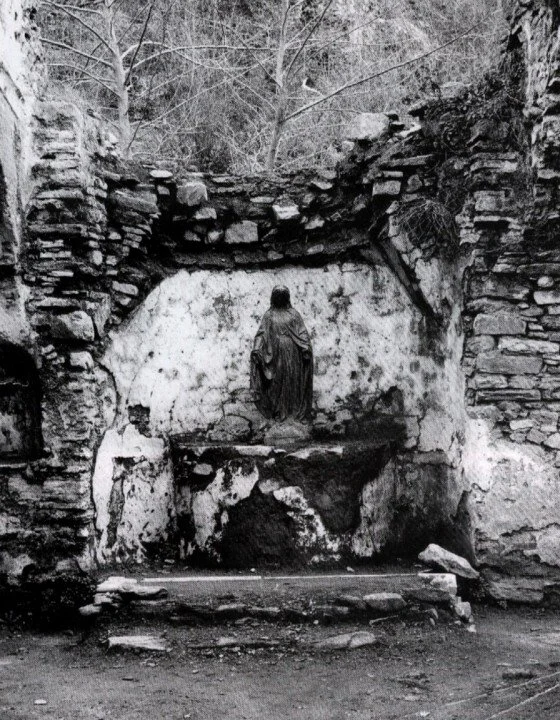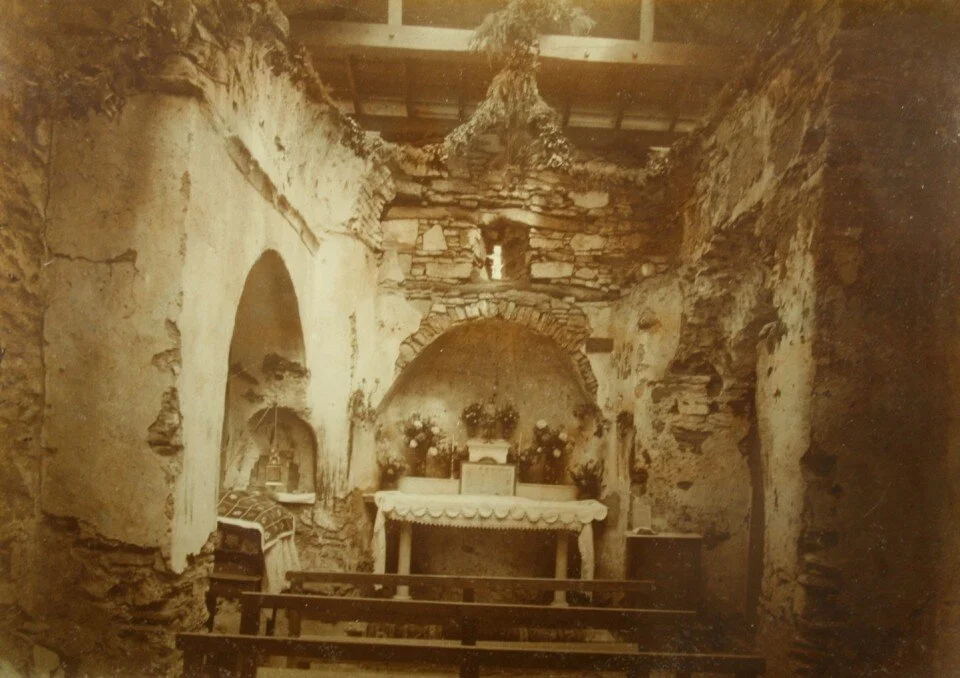The House of the Blessed Virgin, Mary (Selçuk, Turkey).
In the first chapter of the Bible’s Gospel of St. Luke we learn that we are to call Mary “blessed” – as in the Blessed Virgin Mary. It is believed by many that St. Luke personally interviewed Mary about the miraculous events leading to the virgin birth of her son. The angel Gabriel (or “Jibrîl”) appeared to Mary in Nazareth to announce that she would give birth to a son whose name would be Jesus (or “Isa”). The angel said to her: “Blessed are you among women!” (Luke 1:28). Mary went to visit her relative Elizabeth in the city of Judah to share the wonderful news. Upon entering, Elizabeth spoke out with a loud voice and said, “Blessed are you among women, and blessed is the fruit of your womb!” (Luke 1:42). Mary replied in a song known as the Magnificat that, “henceforth all generations will call me blessed.” (Luke 1:48). Similarly in the Koran, the holy book of the Muslim faith, the angel says to Mary, “O Marium! surely Allah has chosen you and purified you and chosen you above the women of the world.” (The ‘Imrans 3:41). From these verses in these holy books of the world’s two largest religions we learn from God’s own messenger, an angel, that Mary is truly blessed among all women, chosen above all women in the world; and then from Mary herself that all generations are to call her “blessed.” The house in Turkey, on a mountaintop is, therefore, a sacred place for both Christians and Muslims.
The French Lazarist priests who discovered the small stone house in July 1891 were startled to learn that the locals called the place “Panaghia-Capouli” which meant “The Door of the Holiest.” Perhaps more remarkable to us today is the fact that the annual pilgrimage took place each year on August 15th, which was not declared the Feast of the Dormition of the Immaculate Virgin Mary until 1950. Today, some use the name “Panaya Kapulu” to describe the house on the hillside.
Visiting Mary’s House
The house is open to visitors year-round. Here is the schedule of religious services:
November – April:
Holy Rosary 4:30 PM
Holy Mass 5:00 PM
Sundays 10:30 AM & 5:00 PM
May – October:
Holy Rosary 5:30 PM
Holy Mass 6:00 PM
Sundays 10:30 AM & 6:00 PM
Blessed Anne Catherine Emmerich.
Anne Catherine Emmerich (pictured right) was the daughter of a German peasant couple, and she worked as a seamstress and servant before entering an Augustinian convent at Dülmen, Germany in 1802. She came from a poor background and was barely literate. At age 24, she began to physically experience the sufferings of Christ’s persecution, including the stigmata. From her bed in a village of Westphalia, where she spent the last 12 years of her life, Anne Catherine Emmerich received visions of the lives of both Jesus and His mother, Mary. These visions were recorded and published after her death by the German writer Clemens Brentano. Her stigmata was verified by a doctor who published a detailed account in 1814 in the Medical Journal of Salzburg. In her later years, these visions became increasingly vivid and she would relay them to Brentano who kept a running journal of her revelations. These accounts are rich with details on geography, dates, events, and names, all remarkably consistent with Scripture and scholarly history.
Following Sister Emmerich’s death in 1824, Brentano set to work on arranging the writings in chronological order and compiling them into two separate books. The first, The Dolorous Passion of Our Lord Jesus Christ, was published in 1835. The second, a compilation of Emmerich’s visions about Mary, was not published until after Brentano himself died in July 1842. The task of publishing Emmerich’s writings about Mary fell first to his brother, Christian Brentano who died in 1851, then to Christian’s widow. That book was finally published as The Life of the Blessed Virgin Mary. The popular 2004 film by Mel Gibson, The Passion of the Christ, was based largely on the director’s reading of Sister Emmerich’s visions, which inspired him to make the movie.
In her visions, Sister Emmerich described with great detail the geography of Ephesus, its location to the sea and the many roads leading into the major port city in Asia Minor. She mentioned many caves in the mountain. The location was described as “some three and a half hours from Ephesus.” Today, the car ride from Ephesus to Meryem Ana Evi, up the paved road to Bulbul Dagh, is less than thirty minutes. But in the 1st Century, the trek up the mountain side would have taken several hours. In describing the mountain, Emmerich says that, “This hill slopes steeply towards Ephesus,” which Bulbul Dag does as it rises to the south of the ancient city of Ephesus.
In Blessed Emmerich’s visions, Mary was visited on occasion by “an Apostle or disciple on his travels,” and, of course, Emmerich saw one man going in and out of the house more often than others, and said, “I always took him to be [Saint] John.” She had a revelation that St. John did not remain permanently near the Blessed Virgin, but, “He came and went in the course of his travels. Emmerich said of the house St. John had built for the Blessed Virgin that it was unique among the village in that, “Mary’s Home was the only one built of stone . . . built of rectangular stones, rounded or pointed at the back.” She said that, “Between the Blessed Virgin’s dwelling and Ephesus runs a little stream which winds about in a very singular way.”
Sister Emmerich accurately described the view from the top of the mountain on which Mary’s Home was built. She said, “A little way behind it was the summit of the rocky hill from which one could see over the trees and hills to Ephesus and the sea with its many islands.” This perfectly describes the view from the top of Bulbul Dagh mountain, from which one can even today see the ancient city of Ephesus below and on a clear day can view the sea and the island of Samos to the west. On July 7, 2004, Saint Pope John Paul II approved a decree authorizing Emmerich’s beatification and on October 3, 2004 during a Mass in St. Peter’s Square in Rome, Anna Catherine Emmerich was formally beatified.
Anne Catherine Emmerich
The Discovery by the French Lazarists (July 1891)
Father Eugene Poulin’s diary of the remarkable expedition in 1891 was first translated from his native French into English and published in 1999 by a Turkish publisher. See, P. Eugene Poulin, The Holy Virgin’s House, The True Story of its Discovery, Arikan Yayinlari Tic., Istanbul (1999). Fr. Poulin (1843 – 1928) was age 47 when in mid-November 1890 he first encountered the writings of Blessed Anne Catherine Emmerich, a visionary whose writings he thought were utter nonsense. As a young priest in France, Poulin and his colleges used to mock the “women visionaries” and laugh at those to followed her writings, yet he had not read a single word of them. His life changed forever when he stumbled onto a book in the college library at Smyrna titled, “The Suffering Passion of Jesus Christ, according to Catherine Emmerich’s visions.” To his surprise, Poulin found the book completely engaging. “It was something very pious,” he recalled, “very simple, all conforming to good sense.” He was astonished to find a certain sweetness in her words and style, “which invaded you slowly, going straight to your heart.” When he shared his discovery with the other priests in Smyrna, he was mocked. “Nonsense!” said one; “Girlish dreams!” said another. He found himself on the defensive, the brunt of their jokes. Poulin, who was afflicted with a stammer, struggled to convince them to just read a bit of Emmerich. He continued his arguments for the next month or so until one evening in January 1891, the debate was renewed. An elderly priest, Father Dubulle, revealed to Poulin that Emmerich’s visions were contained in yet another book, one about the Blessed Virgin’s Life. Fr. Dubulle gave him a copy of the small black, bound book titled, “The Holy Mary’s Life According to the Visions of C. Emmerich,” a translated copy from the original German text.
Father Poulin read Emmerich’s revelations about Mary and the last chapters, about Mary’s life in Ephesus, her house, her death and her tomb, caught his interest. After all, he was living in Turkey and not far from Ephesus but had never heard of this version of Her life, since prevailing doctrine was that Mary had lived and died in Jerusalem following the Crucifixion. “What is this?” he exclaimed out loud. The new revelation started another debate among the French priests at Smyrna, which lasted for months. Finally, to end the debate it was agreed that as soon as the summer holiday came, an expedition would be made to Ephesus. If the house was as Emmerich described it, they should be able to find it by using her detailed descriptions. If not, then “nobody will speak about her any more.” The resolution ended the argument and the priests planned to make their investigation in June, 1891.
On Wednesday, July 29, 1891, a group of priests led by Fr. Henri Jung set out on foot, using Emmerich’s writings like a surveyor’s map, compass in hand. Stopping for a moment, Father Jung spotted some trees up on the right of the mountain. “Let us go up there,” he said, hoping that if there were trees there might be a stream as described in the book. The hot July sun was in full force and as the ascent became steeper, the tired bodies felt the strain. Covered in sweat, their clothes stuck to the skin. Stopping periodically to wipe their faces, they plodded ahead. “Our legs could not walk any more; they refused to serve us, it was necessary to stop and take a rest, a breath,” one of the men recalled. Suddenly, the group spotted some women working in tobacco fields. They rushed forward pleading for “Water! Water!” To their disappointment, the women said they had no water but advised that by the “monastery” there is a spring, pointing to a place some 10 minutes further. As the explorers refreshed themselves by the spring, something about the “monastery” – a stone hut – attracted the attention of Fr. Jung, who examined it closely. It was clearly an ancient ruin. Then he remembered something. Those fields and that terrace they had just crossed . . . this ancient ruin . . . these rocks; that mountain behind . . . the sea in front; the island of Samos and its innumerable peaks . . . what did it all mean? Could it be that without knowing it, they had found just the house they were looking for?” Good heavens! Jung thought to himself. “Quickly, hurry!” he shouted, “We must be sure!” Jung recalled how Emmerich decribed the view from the mountaintop above the house. With new energy, he ran quickly straight up the mountain, with two other men close behind, wanting to share in the discovery. Reaching the summit of Bulbul Dag, Fr. Jung took in the scenery in the clear Turkish air.
Yes, he could clearly make out the ancient city of Ephesus to the north. He then peered to the west and almost gasped. “The sea!” He could see the blue water spread out on the horizon, just as Emmerich had seen it from her bed in Germany. He was thrilled at the realization that the German nun was right after all! They had found the stone house that St. John had built for Mary. A few days later, Fr. Jung learned from the locals the name given to the old house on the terrace: “Panaghia-Capouli, The Door of the Holiest.”
For more information on Mary’s House, see the article:
Mary’s House in Ephesus, Turkey: Interfaith Pilgrimage in the Age of Mass Tourism, by Amelia Gallagher, Ph.D., Vincentian Heritage Journal, Vol. 33, Issue 2 (Fall 2016).
Fr. Henri Jung, C.M. (1843-1912)
Papal Visits.
Since the work done by the Archbishop of Izmir (Smyrna), ASE and the Dernek of Mother Mary, three popes have visited Mary’s House: Blessed Pope Paul VI in 1967, Saint John Paul II in 1979, and Pope (Emeritus) Benedict XVI in 2006, each of whom celebrated Mass there. There are reported to have been many miraculous cures and favors granted to pilgrims at Ephesus. Blessed Pope Paul VI, the first pope to visit Mary’s House, did so on July 26, 1967. Saint Pope John Paul II celebrated Mass at Mary’s House during his historic visit on November 30, 1979. The last pope to visit Mary’s House in Ephesus, was Pope (Emeritus) Benedict XVI, who did so on November 29, 2006. Photos of the three papal visits are shown in the gallery above.
